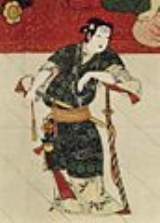
Kabukimono
Encyclopedia

Japan
Japan is an island nation in East Asia. Located in the Pacific Ocean, it lies to the east of the Sea of Japan, China, North Korea, South Korea and Russia, stretching from the Sea of Okhotsk in the north to the East China Sea and Taiwan in the south...
, between the end of the Muromachi era
Muromachi period
The is a division of Japanese history running from approximately 1336 to 1573. The period marks the governance of the Muromachi or Ashikaga shogunate, which was officially established in 1338 by the first Muromachi shogun, Ashikaga Takauji, two years after the brief Kemmu restoration of imperial...
(AD
Anno Domini
and Before Christ are designations used to label or number years used with the Julian and Gregorian calendars....
1573) and the beginnining of the Edo period
Edo period
The , or , is a division of Japanese history which was ruled by the shoguns of the Tokugawa family, running from 1603 to 1868. The political entity of this period was the Tokugawa shogunate....
, (AD 1603). Kabukimono is often translated into English as 'strange things' or 'the crazy ones', believed to be derived from kabuku meaning 'to slant' or 'to deviate'. They were masterless or wandering samurai
Samurai
is the term for the military nobility of pre-industrial Japan. According to translator William Scott Wilson: "In Chinese, the character 侍 was originally a verb meaning to wait upon or accompany a person in the upper ranks of society, and this is also true of the original term in Japanese, saburau...
or ronin
Ronin
A or rounin was a Bushi with no lord or master during the feudal period of Japan. A samurai became masterless from the death or fall of his master, or after the loss of his master's favor or privilege....
, or men who had once worked for samurai families who, during times of peace, formed gangs.
Kabukimono would often dress in flamboyant clothing, combining colors such as yellow and blue, and often accessorizing by wearing kimono
Kimono
The is a Japanese traditional garment worn by men, women and children. The word "kimono", which literally means a "thing to wear" , has come to denote these full-length robes...
s meant for women as cloaks, or velvet lapels. Kabukimono also often had uncommon hairstyles and facial hair, either styled up in various fashions, or left to grow long. Their katana
Katana
A Japanese sword, or , is one of the traditional bladed weapons of Japan. There are several types of Japanese swords, according to size, field of application and method of manufacture.-Description:...
would often have fancy hilts. It is also said that Izumo no Okuni
Izumo no Okuni
was the originator of kabuki theater. She was believed to be a miko at the Grand Shrine of Izumo who began performing this new style of dancing, singing, and acting in the dry riverbeds of Kyoto.-Early years:...
borrowed heavily from the style and the personality of the kabukimono when she first started performing in Kyoto, which eventually led to the creation of the classical Kabuki
Kabuki
is classical Japanese dance-drama. Kabuki theatre is known for the stylization of its drama and for the elaborate make-up worn by some of its performers.The individual kanji characters, from left to right, mean sing , dance , and skill...
theatrical form.
Kabukimono were often very violent and rude, doing things such as not paying at restaurants and stealing money from townsfolk. Cases of cutting down people simply to try a new sword, or large incidents of violence were common in areas where kabukimono could be found, in large cities such as Edo
Edo
, also romanized as Yedo or Yeddo, is the former name of the Japanese capital Tokyo, and was the seat of power for the Tokugawa shogunate which ruled Japan from 1603 to 1868...
and Kyoto
Kyoto
is a city in the central part of the island of Honshū, Japan. It has a population close to 1.5 million. Formerly the imperial capital of Japan, it is now the capital of Kyoto Prefecture, as well as a major part of the Osaka-Kobe-Kyoto metropolitan area.-History:...
. Wrestling or dancing in the streets were also common. The peak of kabukimono activity was during the Keichō
Keicho
was a after Bunroku and before Genna. This period spanned from October 1596 to July 1615. The reigning emperors were and .-Change of era:* 1596 : The era name was changed to Keichō to mark the passing of various natural disasters...
period (1596–1615), although also during that time, the bakufu (shogunate) became more strict, and the kabukimono faded away.
It is thought that the modern yakuza
Yakuza
, also known as , are members of traditional organized crime syndicates in Japan. The Japanese police, and media by request of the police, call them bōryokudan , literally "violence group", while the yakuza call themselves "ninkyō dantai" , "chivalrous organizations". The yakuza are notoriously...
originated from groups of kabukimono; though other scholars believe that the yakuza origins are to be found in the , a form of private police.

